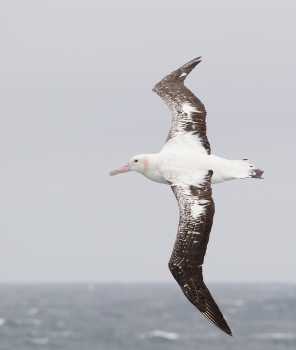MARE – Marine and Environmental Sciences Centre, University of Coimbra, Portugalsexual segregation in globally Vulnerable Wandering Albatrosses Diomedea exulans while foraging.
The paper’s abstract follows:
“Sexual segregation in foraging habitat occurs in many marine predators and is usually attributed to competitive exclusion, different parental roles of each sex or niche specialisation associated with sexual size dimorphism. However, relatively few studies have attempted to understand the patterns and underlying drivers of local-scale sexual segregation in marine predators. We studied habitat use, diet and feeding ecology of female and male wandering albatrosses Diomedea exulans, fitted with GPS and stomach-temperature loggers during the chick-rearing period (austral winter) at South Georgia in 2009. During this period, when oceanographic conditions were anomalous and prey availability was low in waters near the breeding colony, the tracked wandering albatrosses showed high consistency in their foraging areas at a large spatial scale, and both males and females targeted sub-Antarctic and subtropical waters. Despite consistency in large-scale habitat use, males and females showed different foraging behaviours in response to oceanographic conditions at a smaller scale. Males appeared to be more opportunistic, scavenging for offal or non-target fish discarded by fishing vessels in less productive, oceanic waters. They exhibited sinuous movements, feeding mostly on large prey and consuming similar amounts of food during the outbound and return parts of the foraging trip. In contrast, females targeted natural productivity hotspots, and fed on a wide variety of fish and cephalopods. They commuted directly to these areas; most prey were ingested on the outbound part of the trip, and they often started their return after ingesting large prey at the farthest point from the colony. Together, these results indicate that sexual segregation in core foraging areas of wandering albatrosses is driven by sex-specific habitat selection due to the low availability of prey in local Antarctic waters. This segregation results in different feeding behaviour at local scales which may be explained by differing breeding roles and degree of parental investment by each sex, with females investing more than males in reproduction. Further investigations are necessary to confirm the existence of this pattern through time under contrasting environmental conditions and to identify the drivers responsible for local-scale sexual segregation in wandering albatrosses.

Wandering Albatross at sea, photograph by John Chardine
With thanks to Richard Phillips.
Reference:
Pereira, J.M., Paiva, V.H., Phillips, R.A. & 2018. The devil is in the detail: small-scale sexual segregation despite large-scale spatial overlap in the wandering albatross. Marine Biology 165: 55. doi.org/10.1007/s00227-018-3316-0.
John Cooper, ACAP Information Officer, 01 March 2018

 English
English  Français
Français  Español
Español